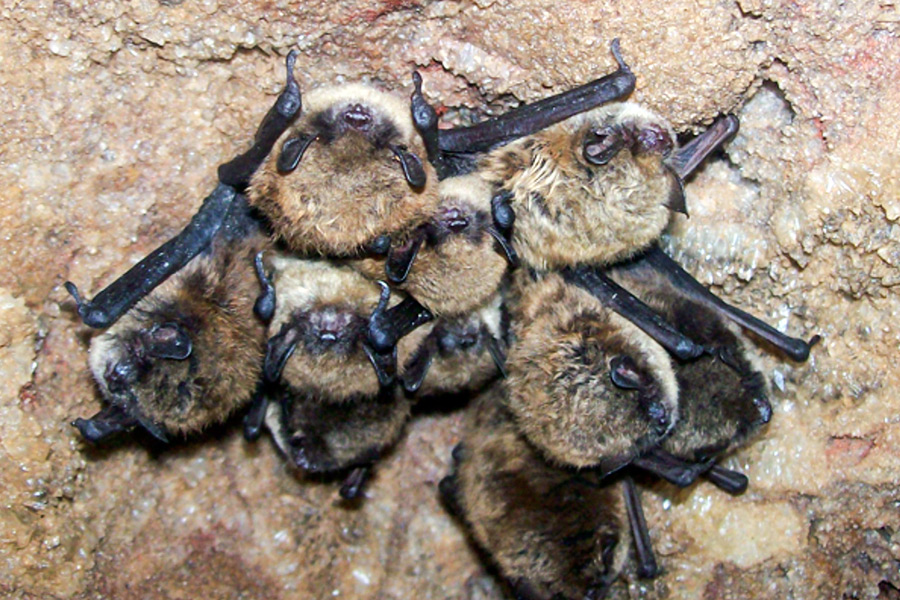A deadly fungal disease that is decimating bat populations across North America was recently confirmed in Washington, marking the first time it has been reported in this region.
The U.S. Fish and Wildlife Service announced Thursday that white-nose syndrome has been confirmed in a little brown bat found near North Bend east of Seattle. The U.S. Geological Survey’s National Wildlife Health Center verified the disease.
Millions of bats have died across eastern North America because of the mysterious fungal disease, and the potential for dramatic ecological imbalances has researchers scrambling to learn more about the fungus, which was first documented nearly a decade ago.
White-nose syndrome is not known to pose a threat to humans, pets, livestock or other wildlife.
On March 11, hikers found the sick bat about 30 miles east of Seattle near North Bend, and took it to Progressive Animal Welfare Society (PAWS) for care. The bat died two days later, and had visible symptoms of a skin infection common in bats with white-nose syndrome.
PAWS submitted the bat for testing to the USGS National Wildlife Health Center, which confirmed through fungal culture, molecular and pathology analyses that it had the disease.
The discovery marks the first time the disease has been confirmed in the Western U.S.
“We are extremely concerned about the confirmation of WNS in Washington state, about 1,300 miles from the previous westernmost detection of the fungus that causes the disease,” said U.S. Fish and Wildlife Service Director Dan Ashe. “Bats are a crucial part of our ecology and provide essential pest control for our farmers, foresters and city residents, so it is important that we stay focused on stopping the spread of this fungus. People can help by following decontamination guidance to reduce the risk of accidentally transporting the fungus.”
Bats devour massive quantities of insects, with one study estimating that the winged mammals annually save the U.S. agricultural industry as much as $50 billion in pest control. They also kill insects that are either a nuisance or potentially dangerous to humans because of disease – a single, small brown bat can eat 1,200 mosquito-sized insects in an hour, while a colony of 150 large brown bats can devour 33 million cucumber beetles in a summer.
»»» Click here to read about caving expeditions in Northwest Montana that involve bat research
First seen in North America in the winter of 2006/2007 in eastern New York, white-nose syndrome has now spread to 28 states and five Canadian provinces. USGS microbiologist David Blehert first identified the unknown fungus, Pseudogymnoascus destructans, which causes the disease. WNS is named for the fuzzy white fungal growth that is sometimes observed on the muzzles of infected bats. The fungus invades hibernating bats’ skin and causes damage, especially to delicate wing tissue, and physiologic imbalances that can lead to disturbed hibernation, depleted fat reserves, dehydration and death.
“This finding in a far-western location is unfortunately indicative of the challenges we face with the unpredictability of WNS,” said Suzette Kimball, director of the USGS. “This underscores the critical importance of our work to develop tools for early detection and rapid response to potentially devastating wildlife diseases.”
Researchers in Northwest Montana are studying bats in an effort to gain a greater understanding of how to help the species survive.
The U.S. Fish and Wildlife Service leads the national WNS response effort, working with state and federal partners to respond to the disease. The agency’s National White-nose Syndrome Coordinator Jeremy Coleman said the first step will be to conduct surveillance near where the bat was found to determine the extent of WNS in the area. The Washington Department of Fish and Wildlife (WDFW) is responsible for bat management and conservation in Washington and will coordinate surveillance and response efforts.
WDFW veterinarian Katie Haman said the disease is transmitted primarily from bat to bat, although people can carry fungal spores on their clothing, shoes or caving gear.
“The bat found near North Bend most likely had been roused from hibernation and was attempting to feed at a time of very low insect availability,” Haman said. “At this point we don’t know where the infected bat may have spent the winter, but it seems likely that it was somewhere in the central Cascades.”
Haman said Washington state has 15 species of bats that benefit humans by consuming large quantities of insects that can impact forest health and commercial crops.
WDFW advises against handling animals that appear sick or are found dead. If you find dead bats or notice bats exhibiting unusual behavior such as flying outside during the day or during freezing weather, please report your observation online or contact the WDFW Wildlife Health Hotline at (800) 606-8768.
